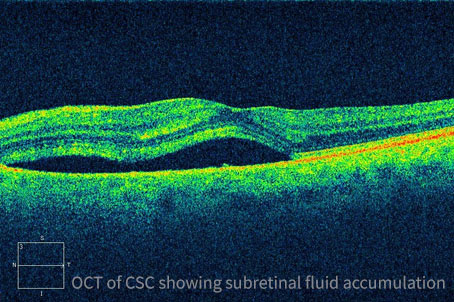
To view a PDF version of this information, click here.

Central serous chorioretinopathy (CSR or CSC) is a multifactorial disease that usually affects young to middle aged men and women, though patients of all ages can be affected. CSC results in accumulation of fluid under the retina leading to central vision disturbances such as blurriness, micropsia (smaller appearance of objects), and distortion. It can occur in one or both eyes and recurrences are not uncommon.
Though the exact cause is unknown, CSC is secondary to abnormal circulation of choroid, the layer below the retina. The disease has been related to elevated corticosteroid levels and Type A behavioral pattern. Patients are often on corticosteroid medications.
CSC is diagnosed based on clinical exam and special testing such as optical coherence tomography (OCT), fluorescein angiography (FA), and indocyanine green angiography (ICGA).
Most cases of CSC resolve spontaneously over the course of 3-4 months, though there is usually a mild remnant visual disturbance. Therefore, most times observation is recommended. In more refractory cases, your physician may recommend focal macular laser or photodynamic therapy (PDT).

